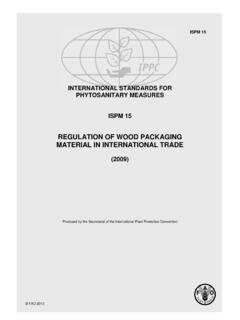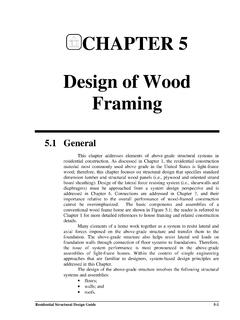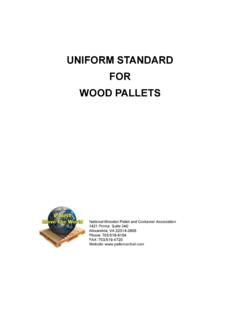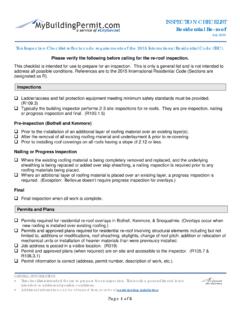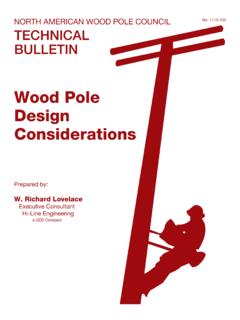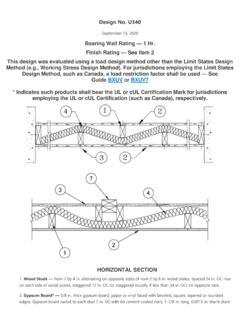Transcription of Glulam Design Properties and Layup ... - Weather Wood Siding
1 GLULAMDESIGNPROPERTIESANDLAYUPCOMBINATIO NSENGINEERED WOOD SYSTEMSENGINEERED WOOD SYSTEMSWood is the right choice for a host of construction applications. It is theearth s natural, energy efficient and renewable building wood is a better use of miracle in today s woodproducts is that they make more efficient use of the wood fiber resource to make stronger plywood, oriented strand board, I-joists, glued laminatedtimbers, and laminated veneer lumber. That s good for the environment, and good fordesigners seeking strong, efficient, and striking building few facts about wood. We re not running out of of the United States land base 731 million acres is covered by forests.
2 About two-thirds of that 731million acres is suitable for repeated planting and harvesting of timber. Butonly about half of the land suitable for growing timber is open to of that harvestable acreage also is open to other uses, such ascamping, hiking, and hunting. Forests fully cover one-half of Canada s land mass. Of this forestland, nearly half is considered productive, or capable of producing timber on asustained yield basis. Canada has the highest per capita accumulation of protected naturalareas in the world areas including national and provincial parks. We re growing more wood every landowners plant more than two billion trees every year.
3 In addition, millions of trees seednaturally. The forest products industry, which comprises about 15 percentof forestland ownership, is responsible for 41 percent of replanted forestacreage. That works out to more than one billion trees a year, or aboutthree million trees planted every day. This high rate of replanting accounts for the fact thateach year, 27 percent more timber is grown than is harvested. Canada s replanting recordshows a fourfold increase in the number of trees planted between 1975 and 1990. Manufacturing wood is energy products made up 47 percent of allindustrial raw materials manufactured in theUnited States, yet consumed only 4 percentof the energy needed to manufacture allindustrial raw materials, according toa 1987 study.
4 Good news for a healthy every ton of wood grown, a young forest produces tons of oxygen and absorbs tons ofcarbon , the miracle material for the environment, for Design , and for strong, lasting Miracle material Percent ofPercent ofMaterialProductionEnergy UseWood474 Steel2348 Aluminum28 NOTICE:The recommendations in thisreport apply only to Glulam thatbears the APA EWS Glulam bearing theAPA EWS trademark is subjectto the Association s qualityauditing 0000 ANSI Y117 EWS SP3 Glulam DESIGNPROPERTIES ANDLAYUP COMBINATIONSI ntroductionGlued laminated timbers ( Glulam ) aremanufactured by end joining individualpieces of dimension lumber or boardstogether with structural adhesives to cre-ate long length laminations.
5 These longlength laminations are then face bondedtogether with adhesives to create thedesired Glulam shape. Through the lami-nating process, a variety of shapes can becreated ranging from straight rectangularcross-sections to complex curved shapeswith varying cross-sections. Thus, glulamis one of the most versatile of the family ofglued engineered wood products and isused in applications ranging from con-cealed beams and headers in residentialconstruction to soaring domed Layup PrinciplesBending MembersIn addition to being able to producevirtually any size or shape of structuralmember, the laminating process alsopermits the manufacturer to optimize theuse of the available wood fiber resourceby selecting and positioning the lumberbased on the stresses it will be subjectedto in-service.
6 For example, for membersstressed primarily in bending, a gradedlayup of lumber is used throughout thedepth of the beam with the highest quality laminations used in the outerzones of the beam where the bendingstresses are highest. Lower quality lamina-tions are used in zones subjected to lowerbending stresses. Layup combinations formembers stressed primarily in bendingare provided in Table 1. These membersmay range in cross-section from straightrectangular beams to pitched and taperedcurved indicated in Table 1, bending mem-bers can be further divided into balancedand unbalanced layups as shown inFigure 1.
7 Unbalanced beams are asym-metrical in their layups with the highestquality laminations, referred to as tensionlaminations, used only on the bottom ofthe member. These are intended for usein simple-span applications or short,cantilevered conditions where only thebottom of the beam is subjected to maxi-mum tension stresses. Results of a largenumber of full-scale beam tests con-ducted or sponsored by the glued lami-nated timber industry over the past 30years have shown that the quality of thelaminations used in the outer tensionzone controls the overall bendingstrength of the a balanced beam, the grade of laminations used is symmetrical through-out the depth of the member.
8 This typeof member is typically used for cantileverFIGURE 1 BALANCED VERSUS UNBALANCED Layup EXAMPLET. L . No. 1No. 2No. 3No. 2No. 1T. L . No. 2 DNo. 2No. 2No. 3No. 2No. 1T. L . = Tension LaminationBalancedUnbalancedor continuous, multiple-span beamswhich may have either the top or bottomof the member stressed in addition to stamping the beam with the APA EWStrademark signifying that the member has been manufactured inaccordance with the provisions of ANSIS tandard for Structural GluedLaminated Timber, unbalanced beams alsohave the word TOP prominently stampedon the top of the member as shown inFigure 2.
9 This is provided as guidance tothe contractor to ensure that the memberis installed with the proper orientation. Ifmembers are inadvertently installed withan improper orientation, , upsidedown, the allowable Fbvalue for thecompression zone stressed in tension isapplicable. The controlling bendingstress and the capacity of the beam inthis orientation must be checked todetermine if they are adequate to meetthe Design Loaded MembersFor members stressed primarily in axialtension or axial compression, where thestresses are uniform over the cross-section of the member, single-grade lamination layups, such as those given in Table 2 are recommended since there isno benefit to using a graded Stress MembersIf the member is to be subjected to highbending stresses as well as axial stresses,such as occur in arches or beam-columns.
10 A bending member combina-tion as tabulated in Table 1 is typicallythe most efficient. Tapered beams orpitched and tapered curved beams arespecial configurations that are also specified using Table 1 bending member of Allowable StressesThe laminating process used in the manufacture of Glulam results in a ran-dom dispersal of naturally occurringlumber strength-reducing characteristicsthroughout the Glulam member. Thisresults in mechanical Properties for glu-lam having higher values and lower vari-ability as compared to sawn lumberproducts. For example, the coefficient ofvariation for the modulus of elasticity (E)of Glulam is published as 10% which isequal to or lower than any other Glulam is manufactured with kiln-dried lumber having a maximum moisturecontent at the time of fabrication of 16%,this results in higher allowable designstresses as compared to dry (moisturecontent of 19% or less) or green use of kiln-dried laminating lumberalso means that the moisture content of aglulam is relatively uniform throughoutthe member unlike green sawn timberswhich may have widely varying moisturecontents within a given member.
